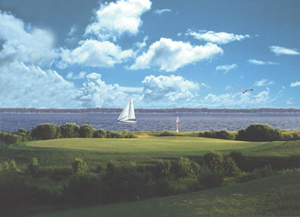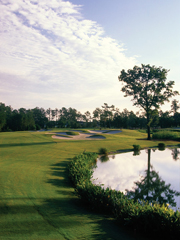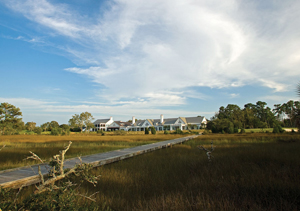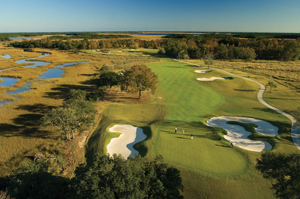Featured Golf News
Golf in Carolina's Low Country
They call it the Low Country, that strip of land by the ocean that runs from South Carolina into Georgia. While the country may indeed be low, the living is high, with the epicenter of the region that most charming of Southern cities, Charleston, S.C.
I have the occasion to visit the Charleston area several times each year, checking in with my daughter and son-in-law, who live in Mount Pleasant, a burgeoning suburb of "Charles Towne." Much time is spent on the sandy, warm beaches of The Isle of Palm and Sullivan's Island, two welcoming ocean communities boasting funky cafes and bars, or hanging out in downtown Charleston, with its trendy pubs, restaurants and shops.
The city has a central shopping area called, appropriately "The Marketplace," where hundreds of vendors hawk wares ranging from the trite to the valuable. But the real delight of each trip (other than hanging out with our kids, drinking sweet tea and downing "she crab soup," sausage gravy and homemade biscuits) is sampling the area's fairways and greens.
While Myrtle Beach, an hour-and-a-half drive up Route 17 to the north, gets most of the credit for being a golfer's paradise, Charleston has its own, albeit much smaller, cache of courses to keep you entertained for a week or two. Several new layouts have come on line during the last decade, joining a number of established courses.
Located either in the Charleston or Mount Pleasant area are such solid layouts as Charleston National Country Club, the two courses at Wild Dunes, Patriots' Point Golf Links, Rivertowne Country Club, and the Links of Stono Ferry. These tracks stand up against any in the Palmetto State for design, playability for golfers of all abilities, and price. And, of course, the upscale Kiawah portfolio, which includes the classic Ocean Course, is located close to Charleston.
Let me give you a little rundown on what I consider the best of the bunch in the Charleston area.

Charleston National
Charleston National Golf Club
This may be my favorite. Original plans called for the creation of a national membership-based venue that would rival other such exclusive destination golf clubs. The developers even had an airstrip built not far from the site. That was all before Hurricane Hugo took down some 4,000 wonderful old Spanish moss-draped "live oak" trees and forever altered the land. Proposals for a private facility were abandoned, the course was opened to the public and a tasteful community sprang up on the surrounding acreage.
While the live oaks may be gone, the Rees Jones-designed layout still meanders skillfully through marshes and woods and affords a scenic, pure test of golfing skill. There is some island-hopping on the back nine as you navigate open marshes on tee shots and on the par-3s. Indeed, the course ends in quirky fashion with a par-3 that plays around 175 yards from the back tees and demands a full shot over wetlands. For more information, visit www.charlestonnationalgolf.com.
Wild Dunes Links & Harbor Courses
Again, the ocean, usually in evidence in some form in the Low Country, plays a strong hand in the finishing holes of the resort's Links Course.
The penultimate and final holes (a shortish par-4 and a dogleg-right par-5) at the Links are alone worth the price of admission, as the ocean is a few yards away on the left side.
I like the Links Course at Wild Dunes and it gets most of the attention. But the resort's sister layout, Harbor Course, is a fun track in its own right. Playing only 6,359 yards from the tips, it has a slope of 131, which provides an insight into the demands the layout places on shot-making and course management. Tight fairways and small greens make this a toughy.
For more information, visit http://www.wilddunes.com.

Patriot's Point
Patriot's Point Golf Links
Located on the banks of Charleston Harbor, Patriot's Point offers the feel of a true links. Ocean breezes alter the character of the layout, which ambles though marshlands, lagoons and tidal creeks.
The William Byrd-designed track plays 6,900 yards from the tips with three other sets of tees. This is a playable course (www.patriotspointlinks.com) for all golfers, while offering one of the more scenic and memorable rounds to be had in the area.
The course harbors, pun intended, one of the best par-3s in the area, and certainly one of the most photographed. It's the 17th, where you will likely see sailboats and ocean-going vessels leaving the port of Charleston, which is located right across the bay.

Rivertowne GC
Rivertowne Country Club
Rivertowne is Arnold Palmer's first signature layout in the Charleston area. The course, which hosts an annual LPGA event, is situated among scenic marshlands and majestic live oaks, with 13 holes routed along the Wando River and Horlbeck Creek. The tree-lined fairways provide generous landing areas to set up approach shots to multi-tiered greens guarded by bunkers and water.
Rivertowne (www.rivertownecountryclub.com) is one of the best conditioned facilities in the area and is a real test of playing ability and thoughtful club selection. It's set inland, so you don't get the feel of the ocean here. But there are plenty of marshes to lend that breezy, seaside feeling of the Low Country. Just be ready to share the turf with alligators and blue herons.
Dunes West Golf Club
When entering this magical place, enjoy the straight, long drive up to the stately clubhouse that takes you past tall live oaks draped with Spanish moss.
Dunes West (www.duneswestgolfclub.com) plays from 6,859 yards from the tips to 5,208 yards from the forward markers. Water enters play on seven holes, but the fairways are fairly large and forgiving. The greens are mildly undulating and guarded by bunkers - both sand and grass.
No. four at Dunes West, a 489-yard par-5, is a well thought-out design. A big tee shot leaves the player with an opportunity to go for the green in two. But it demands a carry across a pond that runs down the left side of the fairway to the green. This is risk-reward at its best.
The 16th is a testy par-4 measuring 412 yards. There is a huge sand trap guarding the right side of the fairway, and the approach must be true to a small green guarded along the right by a pond.
The Links at Stono Ferry
The Links at Stono Ferry has won numerous accolades in recent years for its conditioning, design and character. The course is located along the intra-coastal waterway and features a links-style design. The front nine was carved out of stands of massive oaks and pines, while the back nine offers superb views of the marshlands and waterway.
The Ron Garl-designed course (www.stonoferrygolf.com) measures just 6,701 yards from the tips and has a slope of 136, indicating the need for wise club selection and accurate shots, both from the tees and into the tricky greens.
Stono Ferry features six par-4s that measure less than 400 yards, including the delightful 343-yard 18th. So you can score here if you keep it straight off the tee.
Coosaw Creek Country Club
This Arthur Hills design is known as a "playable" public course. The rolling terrain over which the course is routed is somewhat unique to the area and offers a contrasting playing experience. The layout is relatively short (6,543 yards from the tips), but water hazards and strategically placed bunkers put a premium on accuracy off the tee. The greens are undulating and challenging to read. For more details, visit www.coosawcreek.com.
Close to Charleston
You can access the courses at Kiawah through the Kiawah Island Golf Resort (www.kiawahresort.com), which offers a number of packages. On the day we played the fabled Ocean Course, the wind was down and the course was surprisingly benign. Still, it was a real treat, with the final stretch of holes played virtually in the sand dunes, the waves seemingly lapping against the protective mounding on the sides of the holes.
The fairways are rather large but the green complexes are brutal. I can only imagine the difficulty one has in finding the putting surfaces when the wind is blowing even modestly off the ocean.
While the Ocean Course is the famous sister, the other tracts at Kiawah - Turtle Point, Osprey Point, Oak Point and Cougar Point - are all treats in their own rights. Some claim Turtle Point and Osprey Point are as good as the Ocean Course, save for the final stretch of holes.
The two courses at nearby Seabrook Island Resort - Ocean Winds and Crooked Oaks - again are not open to the general public, but the resort (www.discoverseabrook.com) offers stay-and-play packages.
For further information about Charleston, visit www.charlestoncvb.com or call 843/958-3629.

Daniel Island's Clubhouse
And then there's Daniels Island . . .
Before arriving in Mount Pleasant, S.C., I checked in with Julie Dombrowski, the affable and helpful Communications Director for the Daniel Island Company, overseers of a new enclave of good living and recreation only a few miles from downtown Charleston.
The 4,000-acre Daniel Island, formerly owned by the Harry Frank Guggenheim Foundation and used primarily for farming, cattle ranching, and as a private hunting retreat, is now home to around 5,500 fulltime residents that may eventually reach 15,000 at full build-out.

14th Hole at Ralston Creek
Daniel Island is a "New Age" town unto itself, with a commercial center that features a mix of shops, restaurants and offices. There are also schools, places of worship and a seemingly never-ending choice of recreational options, including two superb, private golf courses designed by Tom Fazio and Rees Jones on the 4,000-acre island.
Of course, we were interested in the golf, and the Daniel Island Club boasts two excellent tracks, Beresford Creek and Ralston Creek, the latter home for the Nationwide Tour Championship. Both tracks wind through open seaside meadows and marshes that once echoed with the sounds of shotguns discharged by hunters. The only shots being fired these days are those off the faces of drivers as golfers launch tee shots over the pristine fairways.
Julie set us up for a visit and, when we arrived at the Daniel Island Club, we were greeted by friendly attendants and a professional staff. After warming up on the spacious practice area that includes several putting and chipping greens and a large driving range, we headed out to play the Fazio-designed Beresford Creek. The architect skillfully used what little elevation there is on the property to create clearly defined targets that include the greens heavily guarded by bunkers.

Beresford Creek's 17th Hole
A couple of days later we played Ralston Creek, a Rees Jones' work newer than its sister course and just as good. Picking one over the other is like choosing between apple and peach pie. They both taste great and leave a smile on your face. Ralston Creek is a bit flatter than Beresford Creek and its routing brings the wetlands a tad more into play. Both layouts offer a sense of tranquility that is hard to find on today's busy daily-fee facilities. Indeed, play was very light on the days we played, allowing us to enjoy the game the way it was meant to be and in true Southern style: an unhurried pace that let us drink in the beauty of the land.
There are numerous parks and green spaces on Daniel Island, including the Family Circle Tennis Center and Blackbaud Stadium - both of which host sporting and entertainment events, bicycle, jogging and walking paths and the Bellinger Island Nature Preserve. There is lots going on here, like symphony concerts, sporting events, food and wine festivals, an oyster festival, road races, a jazz fest, the annual Park Day festival, holiday tree lightings, parades, golf and tennis clinics for the kids, a fitness facility and swimming.
Daniel Island and the Daniel Island Club are certainly worth checking out if you're considering making the Low Country a place of part-time or permanent residence. Both are easily accessible via Rt. 526.
For more information, visit www.danielisland.com.
John Torsiello is an editor/writer living in Connecticut. He has written extensively about all aspects of the golf industry for a number of national and regional publications. He is a regular contributor to "Golf Course Industry," "Lawn and Landscape," "Golfing" and "Fairway Living" magazines as well as various online publications. He has strong, ongoing relationships with industry professionals and has worked closely with course owners, architects, developers, course superintendents and general managers around the country. He has won a number of awards for his writing, including first place from the Turf and Ornamental Communicators Association for a piece that appeared in "Golf Course Industry" magazine.
Story Options
 |
Print this Story |
